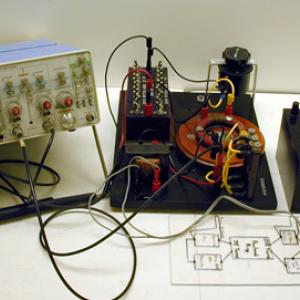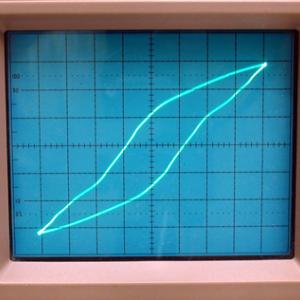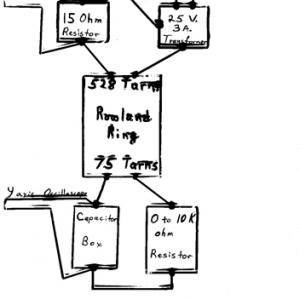College of Liberal Arts & Sciences
5G40.10 - Hysteresis
The unit is designed for a maximum of flexibility in circuit values. The capacitance box and the variable pot allow the demonstrator to show the affect on the hysteresis curve when these values are changed. Plug the outlet plug into a Variac. The BNC cords are labeled and are connected to the appropriate channel of the oscilloscope. Refer to the circuit diagram for assistance if anything becomes unplugged or rearranged. Turn on the Variac to around 70. Adjustment of the capacitor and/or the variable pot may be needed to obtain the best curve although it is usually left on the proper setting when stored. It is normal that the 3 large resistors on the demo board will become quite hot so do not become alarmed. Care should be taken not to touch them when in this condition however.
- Bradley Allen, "From the Simple to the Surprisingly Complex – An Incremental Study of Elasticity", TPT, Vol. 57, #8, Nov. 2019, p. 570.
- Yaakow Kraftmakher, "Hysteresis Loops of a Ferromagnet", TPT, Vol. 43, #7, Oct. 2005, p. 439.
- Deborah Schurr and Tim Usher, "Demonstrating Hysteresis in Ferroelectric Materials", TPT, Vol. 33, #1, Jan. 1995, p. 30.
- Chin-Shan Lue, "A Direct Method for Viewing Ferromagnetic Phase Translation", TPT, Vol. 32, #5, May 1994, p. 304.
- Henry A. Garon, "Mechanical Hysteresis with Inexpensive Equipment", TPT, Vol. 7, #2, Feb. 1969, p. 100.
- Thomas B. Greenslade, Jr., "Rowland's Ring", AJP, Vol. 90, #3, March 2022, p. 250.
- Thomas B. Greenslade, Jr., "Smith's Double-Bar Permeanmeter", AJP, Vol. 81, #2, Feb. 2013, p. 152.
- C. E. Zaspel, A. B. Dahle, L. D. Given, and J. L. Weinert, "A Simple Apparatus for Illustration of Magnetic Hysteresis Effects", AJP, Vol. 72, #2, Feb. 2004, p. 284.
- C. Rudowicz and H. W. F. Sung, "Textbook Treatments of the Hysteresis Loop for Ferromagnets - Survey of Misconceptions and Misinterpretations", AJP, Vol. 71, #10, Oct. 2003, p. 1080.
- Joao Francisco Borin and Oswaldo Baffa, "Measuring Magnetic Properties of Ferromagnetic Materials", AJP, Vol. 66, #5, May 1998, p. 449.
- Edward M. Kiess, "Circuit for Displaying Hysteresis Loop of Two-Terminal Inductors", AJP, Vol. 58, #8, Aug. 1990, p. 794.
- George Barnes, "The Three-Dimensional Hysteresis Surface for Nickel", AJP, Vol. 56, #1, Jan. 1988, p. 45.
- Yunci Meng and Zhujian Liang, "Improvements in the Demonstration of the Hysteresis Loops of Ferromagnetic Materials", AJP, Vol. 55, #10, Oct. 1987, p. 933.
- Frederick Milstein and John A. Baldwin Jr., "Simple Geometrical Means of Visualizing Families of Rayleigh Hysteresis Loops", AJP, Vol. 45, #7, July 1977, p. 634.
- John W. Snider, "Magnetic Hysteresis Measurements With an Integrating Magnetometer", AJP, Vol. 39, #8, Aug. 1971, p. 964.
- Paul Gluck, "Low-Cost Kit Makes Magnetic Hysteresis Demonstration Easy", Physics Education, Vol. 39, #2, Mar. 2004, p. 125.
- G. D. Freier and F. J. Anderson, "Es-10", A Demonstration Handbook for Physics.
- R. W. Pohl, "Magnetic Induction", Physical Principles of Electricity and Magnetism, p. 130.
- Yaakov Kraftmakher, "5.5, Ferromagnetism", Experiments and Demonstrations in Physics, ISBN 981-256-602-3, p. 317.
- Simon Quellen Field, "Measures Used In Permanent Magnets", Gonzo Gizmos, p. 15 - 17.
- "Hysteresis Curve for Steel Ring", Selective Experiments in Physics, CENCO, 1962.
- "Magnetization and Hysteresis Curves for an Iron Rod", Selective Experiments in Physics, CENCO, 1962.
- William J. Hamm, "Physics Experiment #2: The Determination of the B vs. H Curves and the Hysteresis Loop of Magnetic Materials by the Rowland Ring Ballistic Step Method", Keithley Instruments, Series II.
Disclaimer: These demonstrations are provided only for illustrative use by persons affiliated with The University of Iowa and only under the direction of a trained instructor or physicist. The University of Iowa is not responsible for demonstrations performed by those using their own equipment or who choose to use this reference material for their own purpose. The demonstrations included here are within the public domain and can be found in materials contained in libraries, bookstores, and through electronic sources. Performing all or any portion of any of these demonstrations, with or without revisions not depicted here entails inherent risks. These risks include, without limitation, bodily injury (and possibly death), including risks to health that may be temporary or permanent and that may exacerbate a pre-existing medical condition; and property loss or damage. Anyone performing any part of these demonstrations, even with revisions, knowingly and voluntarily assumes all risks associated with them.


